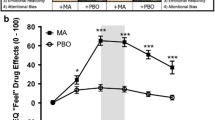Abstract
Conditioned heart rate and skin temperature responses of 12 social drinkers were observed following repeated exposure to alcohol. Each subject received alcohol for four sessions in one room and a non-alcoholic drink for four sessions in a room of quite different appearance. Alcoholic and non-alcoholic drinks were distinctive and the alcoholic content could not be determined on the basis of taste. In the final three testing sessions, placebos were presented in order to test the influence of room and drink cues separately and in combination. A conditioned heart rate response opposite in direction to the alcohol effect was elicited by room and drink cues in combination and by the room cue in isolation. These results were in accordance with the predictions of the conditioning model of tolerance. A conditioned heart rate response in the same direction as the drug effect was elicited by the drink cue presented in isolation. Similar, but non-significant changes were also obtained with skin temperature. In addition, conditioned responses occurred independently of any expectancy. The results demonstrated that the direction of conditioned drug responses may depend on the type of stimulus presented.
Similar content being viewed by others
References
Cappel H, LeBlanc AE (1982) Tolerance and physical dependence: Do they play a role in alcohol and drug self-administration? In: Israel Y, Glaser F, Kalant H, Popham RE, Schmidt W (eds) Research advances in alcohol and drug problems, vol VI. Plenum Press, New York, pp 159–191
Crowell CR, Hinson RE, Siegel S (1981) The role of conditional drug responses in tolerance to the hypothermic effect of ethanol. Psychopharmacology 73:51–54
Dafters RI, Anderson G (1982) Conditioned tolerance to the tachycardia effect of ethanol in humans. Psychopharmacology 78:365–367
Eikelboom R, Stewart J (1981) Temporal and environmental cues in conditioned hypothermia and hyperthermia associated with morphine. Psychopharmacology 72:147–153
Eikelboom R, Stewart J (1982) Conditioning of drug-induced physiological responses. Psychol Rev 89:507–528
Greeley J, Le AD, Poulos C, Cappell H (1984) Alcohol is an effective cue in the conditional control of tolerance to alcohol. Psychopharmacology 83:159–162
Konorski J (1967) Integrative activity of the brain: An interdisciplinary approach. University of Chicago Press, Chicago
Krank MD, Hinson RE, Siegel S (1981) Conditional hyperalgesia is elicited by environmental signals of morphine. Behav Neural Biol 32:148–157
Le AD, Poulos CX, Cappell H (1979) Conditioned tolerance to the hypothermic effect of ethyl alcohol. Science 206:1109–1110
Miksic S, Smith N, Numan R, Lal H (1975) Acquisition and extinction of a conditioned hypothermic response to a tone paired with morphine administration. Neuropsychology 1:277–283
Newlin DB (1986) Conditioned compensatory response to alcohol placebo in humans. Psychopharmacology 88:247–251
O'Brien CP (1975) Experimental analysis of conditioning factors in human narcotic addiction. Pharm Rev 27:533–543
O'Brien CP, Greenstein R, Ternes S, McLellan AT, Grabowski J (1980) Unreinforced self-injections: Effect on rituals and outcome in heroin addicts. In: Harris LS (ed) Problems of drug dependence. NIDA Research Monograph No. 27. US Government Printing Office, Washington DC, pp 275–281
Perkins CC (1968) The consept of reinforcement. Psychol Rev 75:155–172
Razran G (1971) Mind in evolution. Houghton Mifflin, Boston
Shapiro AP, Nathan PE (1986) Human tolerance to alcohol: The role of Pavlovian conditioning processes. Psychopharmacology 88:90–95
Siegel S (1972) Conditioning of insulin-induced glycemia. J Comp Physiol Psychol 78:233–241
Siegel S (1977) Learning and psychopharmacology. In: Jarvik ME (ed) Psychopharmacology in the practice of medicine. Appleton-Century-Crofts, New York, pp 59–70
Siegel S (1978) A Pavlovian conditioning analysis of morphine tolerance. In: Krasnegor NA (ed) Behavioral tolerance: Research and treatment implications. NIDA Research Monograph No. 18. US Government Printing Office, Washington DC, pp 27–53
Siegel S (1983) Classical conditioning, drug tolerance and drug dependence. In: Israel Y, Glaser FB, Kalant H, Popham RE, Schmidt W, Smart RG (eds) Research advances in alcohol and drug problems. vol VII. Plenum Press, New York, pp 207–246
Siegel S, Hinson RE, Krank MD (1981) Morphine-induced attenuation of morphine tolerance. Science 212:1533
Woods SC, Makous W, Hutton RA (1969) Temporal parameters of conditioned hypoglycemia. J Comp Physiol Psychol 69:301–307
Author information
Authors and Affiliations
Rights and permissions
About this article
Cite this article
Staiger, P.K., White, J.M. Conditioned alcohol-like and alcohol-opposite responses in humans. Psychopharmacology 95, 87–91 (1988). https://doi.org/10.1007/BF00212773
Received:
Revised:
Issue Date:
DOI: https://doi.org/10.1007/BF00212773



